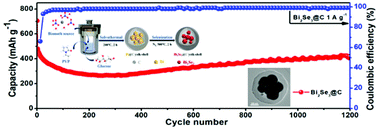Multi-core yolk–shell-structured Bi2Se3@C nanocomposite as an anode for high-performance lithium-ion batteries†
Abstract
Emerging Bi2Se3-based anode materials are attracting great interest for lithium storage because of their high theoretical capacity. Although quite attractive, Bi2Se3 still faces the problem of large volume expansion during lithiation/delithiation, leading to poor cycling stability. Herein, a multi-core yolk–shell Bi2Se3@C nanocomposite was designed and synthesized via a solvothermal method followed by heat treatment. The as-prepared yolk–shell nanocomposite consists of two parts: several Bi2Se3 nanospheres (diameter of approximately 100 nm) as a core, and carbon (thickness of approximately 16 nm) as the shell. Owing to its unique structural features, multi-core yolk–shell Bi2Se3@C nanocomposite demonstrates excellent cycling stability with a capacity of 392.2 mA h g−1 at 0.2 A g−1 after 100 cycles for lithium-ion batteries (LIBs). A reversible capacity of 416.9 mA h g−1 can be maintained even at a higher current density of 1 A g−1 after 1200 cycles. The reason for the superior electrochemical performance was further explored through electrochemical kinetic analysis and theoretical calculations. This work provides an effective strategy for the preparation of multi-core yolk–shell anode materials, and also affords a new method by which to prepare high-performance LIBs.



 Please wait while we load your content...
Please wait while we load your content...